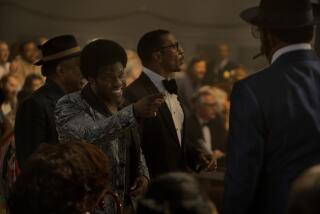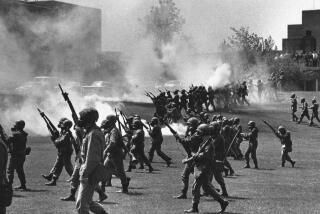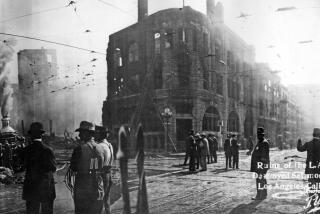REMEMBER THE â60s? : THE ANGER : RADS: The 1970 Bombing of the Army Math Research Center at the University of Wisconsin and Its Aftermath, <i> By Tom Bates (HarperCollins: $25; 446 pp.)</i>
At 3:45 a.m. on Aug. 24, 1970, a bomb aimed at the University of Wisconsinâs Army Math Research Center exploded with such force that it damaged 25 buildings in addition to its target. The blast at the center, where work included research on the electronic targeting of peasants in Vietnam, injured five people and killed a young physicist who opposed the war in Indochina.
If this bombing was not the âsingle most destructive act of sabotageâ in American history--as the dust jacket claims--for the antiwar movement it was destructive enough. Part political, part criminal, the Wisconsin incident with its contradictory message, âPeace--Or Else,â is one of those violent end-of-the-â60s acts that has to be reckoned with by those who ponder what went wrong.
Tom Batesâ âRADSâ is an attempt to tell the story of the Wisconsin bombing with full consciousness of its dual nature. A history graduate student there at the time of the events in question and now a journalist, Bates has constructed a braided narrative that is part biography and part true crime.
First, the biography. The cast of characters of the âNew Yearâs Gangâ (a.k.a. the âVanguard of the Revolutionâ) could be that of any random affinity group from the 1960s. There is Karl Armstrong, both literally and figuratively the engineer of the group--a large, earnest working-class kid from Madison whose true nature is probably best suggested by the fact that when all was said and done he ended up on the streets of Madison running a concession stand called âLoose Juiceâ; his brother Dwight, a high school dropout whose political participation seems less driven by the idealism of his brother than by a drug-inspired adolescent rebellion; David Fine, a Jewish freshman from Wilmington, Del., who already had accumulated a thick FBI file for his antiwar activities by the time he arrived in Madison in 1969; and Leo Burt, a Philadelphia Catholic whose chief love was rowing and whose disappearance in Canada (and the fact that he has not been found) have led to persistent rumors, which the book does not fully dispel, that he was an informant.
The events have a certain familiarity. We see Karl at âDow Day,â the 1967 protest against the company making napalm for Vietnam that gave rise to the first beatings and gassings on an American campus; Karl at the Democratic Convention in Chicago in 1968 (more beatings and gassings); at the student block party in 1969 (likewise busted by the police); at the rally at the ROTC quonset hut (same); at the epiphany where he came to believe that âthe war was going to go on forever and that the only way (it) would stop is if people took violent means to end it . . . And . . . I had even considered suicide. Because I didnât really want to use violence. But if I couldnât live any longer with this war . . . I thought the best way I could die was by resisting it.â
Apart from a simplistic final chapter that seems to place the responsibility for Karlâs radicalism on an abusive father, the biographical elements of âRADSâ generally provide a convincing portrait of the bombersâ personal and political evolution in the shadow of the war. A particular strength is Batesâ examination of the Wisconsin intellectual landscape in which the bomb plot was formed. We see French historian Harvey Goldberg teaching the history of violence and thus appearing to endorse it; European cultural historian George Nosse warning against the consequences of violence, which he witnessed firsthand as a Jewish refugee from the Holocaust, and influential U.S. diplomatic historian William Appleman Williams despairing of ever persuading the radical intellectuals he trained that âpower doesnât roll over and play dead; power fights back.â
If the biographical sections of âRADSâ are generally successful, however, something less must be said for the aspects of the book that belong to true crime. Beginning with the re-creation of the bombing in Chapter 1, many events are told from the point of view of the law officers working the scene. The difficulties with the approach are multiple. For one thing, there are simply far too many characters. There are the campus police, the Madison police, the local FBI men and the national FBI men, all working together--and against--one another, all running informants, all keeping files, all tracking down leads, turning up--and missing--so much in the way of evidentiary minutiae that the point of the story is easily lost. Batesâ list of characters at the beginning helps, but it is not enough to offset the superficiality that such sheer dilution of focus inevitably brings. And so by the time we reach the bookâs finale, which introduces an additional cast of insufficiently individualized district, state, U.S. and Canadian prosecutors, defense attorneys, judges, and witnesses, it has become hard to care.
More problematic than the literary distortion, however, is the political distortion the police drama brings. Police work is intrinsically modular. Everything is broken down into its constituent parts. Events occur in a vacuum. In that respect it is exactly the opposite of the revolutionary political work that the Madison bombers thought they were doing in which everything is seen in terms of connection. From a historical viewpoint it is an extraordinary thing that American students felt so personally responsible for the lives of peasants in Vietnam that they felt they had to act, but to the police it was simply disorder. The police can tell you the length of the fuse, the name of the explosive, the license number of the stolen van in which the bomb was delivered, and the route out of town, but they cannot tell you why it happened. You cannot tell a revolutionary story from a police point of view. The biography and the police drama, like the subjects they cover, are at war.
In a moving introduction (the only first-person commentary the author permits himself), Bates, who participated in many of the events he describes, reveals that though the âradical rhetoric that (once fell) so easily from my own lips now (seems) dangerously puerile . . . my heart remains with those who tried to stop the war in Vietnam.â For many of us who lived through the 1960s, our hearts are indeed a problem. Just when we think we have tamed them into submission with our minds, there they go again, telltale organs, thumping at all the old places, like the hearts of the veterans of the 1930s beating to the songs of the Lincoln Brigade. It seems to me that by uniting the forgiving genre of biography with the judgmental genre of true crime, Bates was attempting to create a narrative that reflected both his sympathies and his doubts. To a certain extent he has succeeded. But it is proof that the author is a genuine veteran of the â60s that âRADSâ still shows signs of struggle.
More to Read
Sign up for our Book Club newsletter
Get the latest news, events and more from the Los Angeles Times Book Club, and help us get L.A. reading and talking.
You may occasionally receive promotional content from the Los Angeles Times.







